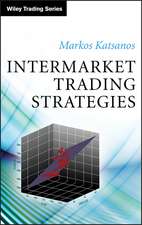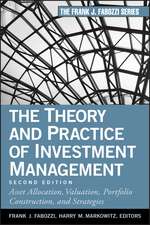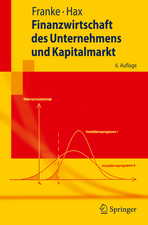Investment and Liquidity Constraints: Empirical Evidence for Germany: neue betriebswirtschaftliche forschung (nbf), cartea 318
Autor Andreas Behren Limba Engleză Paperback – 12 dec 2003
Din seria neue betriebswirtschaftliche forschung (nbf)
- 15%
 Preț: 703.64 lei
Preț: 703.64 lei -
 Preț: 347.73 lei
Preț: 347.73 lei -
 Preț: 370.91 lei
Preț: 370.91 lei -
 Preț: 354.48 lei
Preț: 354.48 lei -
 Preț: 488.07 lei
Preț: 488.07 lei -
 Preț: 490.18 lei
Preț: 490.18 lei -
 Preț: 416.54 lei
Preț: 416.54 lei -
 Preț: 424.81 lei
Preț: 424.81 lei -
 Preț: 483.92 lei
Preț: 483.92 lei -
 Preț: 487.57 lei
Preț: 487.57 lei -
 Preț: 354.17 lei
Preț: 354.17 lei -
 Preț: 458.01 lei
Preț: 458.01 lei -
 Preț: 481.05 lei
Preț: 481.05 lei -
 Preț: 425.80 lei
Preț: 425.80 lei - 15%
 Preț: 473.66 lei
Preț: 473.66 lei -
 Preț: 429.99 lei
Preț: 429.99 lei -
 Preț: 450.33 lei
Preț: 450.33 lei - 15%
 Preț: 444.61 lei
Preț: 444.61 lei -
 Preț: 327.48 lei
Preț: 327.48 lei -
 Preț: 415.95 lei
Preț: 415.95 lei - 15%
 Preț: 471.53 lei
Preț: 471.53 lei -
 Preț: 319.98 lei
Preț: 319.98 lei - 15%
 Preț: 446.08 lei
Preț: 446.08 lei -
 Preț: 442.51 lei
Preț: 442.51 lei - 15%
 Preț: 441.00 lei
Preț: 441.00 lei - 15%
 Preț: 441.19 lei
Preț: 441.19 lei -
 Preț: 425.42 lei
Preț: 425.42 lei -
 Preț: 486.60 lei
Preț: 486.60 lei - 15%
 Preț: 503.04 lei
Preț: 503.04 lei -
 Preț: 483.70 lei
Preț: 483.70 lei - 15%
 Preț: 447.06 lei
Preț: 447.06 lei -
 Preț: 489.10 lei
Preț: 489.10 lei -
 Preț: 449.90 lei
Preț: 449.90 lei -
 Preț: 424.22 lei
Preț: 424.22 lei -
 Preț: 419.21 lei
Preț: 419.21 lei -
 Preț: 419.81 lei
Preț: 419.81 lei -
 Preț: 413.07 lei
Preț: 413.07 lei - 15%
 Preț: 441.69 lei
Preț: 441.69 lei -
 Preț: 421.34 lei
Preț: 421.34 lei -
 Preț: 421.55 lei
Preț: 421.55 lei -
 Preț: 420.58 lei
Preț: 420.58 lei -
 Preț: 417.90 lei
Preț: 417.90 lei -
 Preț: 419.43 lei
Preț: 419.43 lei -
 Preț: 417.52 lei
Preț: 417.52 lei -
 Preț: 435.97 lei
Preț: 435.97 lei -
 Preț: 421.55 lei
Preț: 421.55 lei -
 Preț: 426.94 lei
Preț: 426.94 lei -
 Preț: 427.49 lei
Preț: 427.49 lei -
 Preț: 419.59 lei
Preț: 419.59 lei -
 Preț: 422.11 lei
Preț: 422.11 lei
Preț: 380.07 lei
Nou
Puncte Express: 570
Preț estimativ în valută:
72.73€ • 77.77$ • 60.64£
72.73€ • 77.77$ • 60.64£
Carte tipărită la comandă
Livrare economică 17 aprilie-01 mai
Preluare comenzi: 021 569.72.76
Specificații
ISBN-13: 9783824491278
ISBN-10: 3824491273
Pagini: 184
Ilustrații: XIV, 167 p.
Dimensiuni: 148 x 210 x 10 mm
Greutate: 0.23 kg
Ediția:2003
Editura: Deutscher Universitätsverlag
Colecția Deutscher Universitätsverlag
Seria neue betriebswirtschaftliche forschung (nbf)
Locul publicării:Wiesbaden, Germany
ISBN-10: 3824491273
Pagini: 184
Ilustrații: XIV, 167 p.
Dimensiuni: 148 x 210 x 10 mm
Greutate: 0.23 kg
Ediția:2003
Editura: Deutscher Universitätsverlag
Colecția Deutscher Universitätsverlag
Seria neue betriebswirtschaftliche forschung (nbf)
Locul publicării:Wiesbaden, Germany
Public țintă
ResearchCuprins
1. Introduction.- 2. The Q-theory of investment and the role of internal funds.- 2.1. The Q-Model.- 2.2. Investment, information and incentive problems in capital markets.- 2.3. Conclusion.- 3. Dynamic panel data estimation.- 3.1. The problem of bias caused by lagged dependant variables.- 3.2. Dynamic panel data estimators.- 3.3. Monte Carlo study.- 3.4. Conclusion.- 4. The data source and measurement problems.- 4.1. The data source.- 4.2. The capital stock at replacement costs: A new algorithm.- 4.3. The Calculation of Q.- 4.4. Conclusion.- 5. Empirical findings.- 5.1. Nonparametric regression results.- 5.2. Aggregate and disaggregate Q-investment functions.- 5.3. Testing for liqudity effects in three sectors: manufacturing, construction, commerce.- 5.4. An analysis of size effects.- 5.5. An eclectic approach.- 6. Summary.- References.
Notă biografică
PD Dr. Andreas Behr lehrt am Institut für Ökonometrie und Wirtschaftsstatistik der Universität Münster.
Textul de pe ultima copertă
During the last decade, exploring the link between financial factors and investment has become a major field of theoretical and empirical publications. Some empirical findings indicate that young, fast growing, low dividend paying firms are faced with more liquidity constraints than other firms and therefore show stronger reactions concerning investments to changes of their internal financial flow.
Andreas Behr explores the role of financial factors in a firm's investment decision. He applies the Q-theory of investment to a unique database of German firms (the Deutsche Bundesbank's Corporate Balance Sheet Statistics) covering balance sheet data of 2 314 firms. The empirical results show a strong and significant influence of the calculated Q.
Andreas Behr explores the role of financial factors in a firm's investment decision. He applies the Q-theory of investment to a unique database of German firms (the Deutsche Bundesbank's Corporate Balance Sheet Statistics) covering balance sheet data of 2 314 firms. The empirical results show a strong and significant influence of the calculated Q.
















